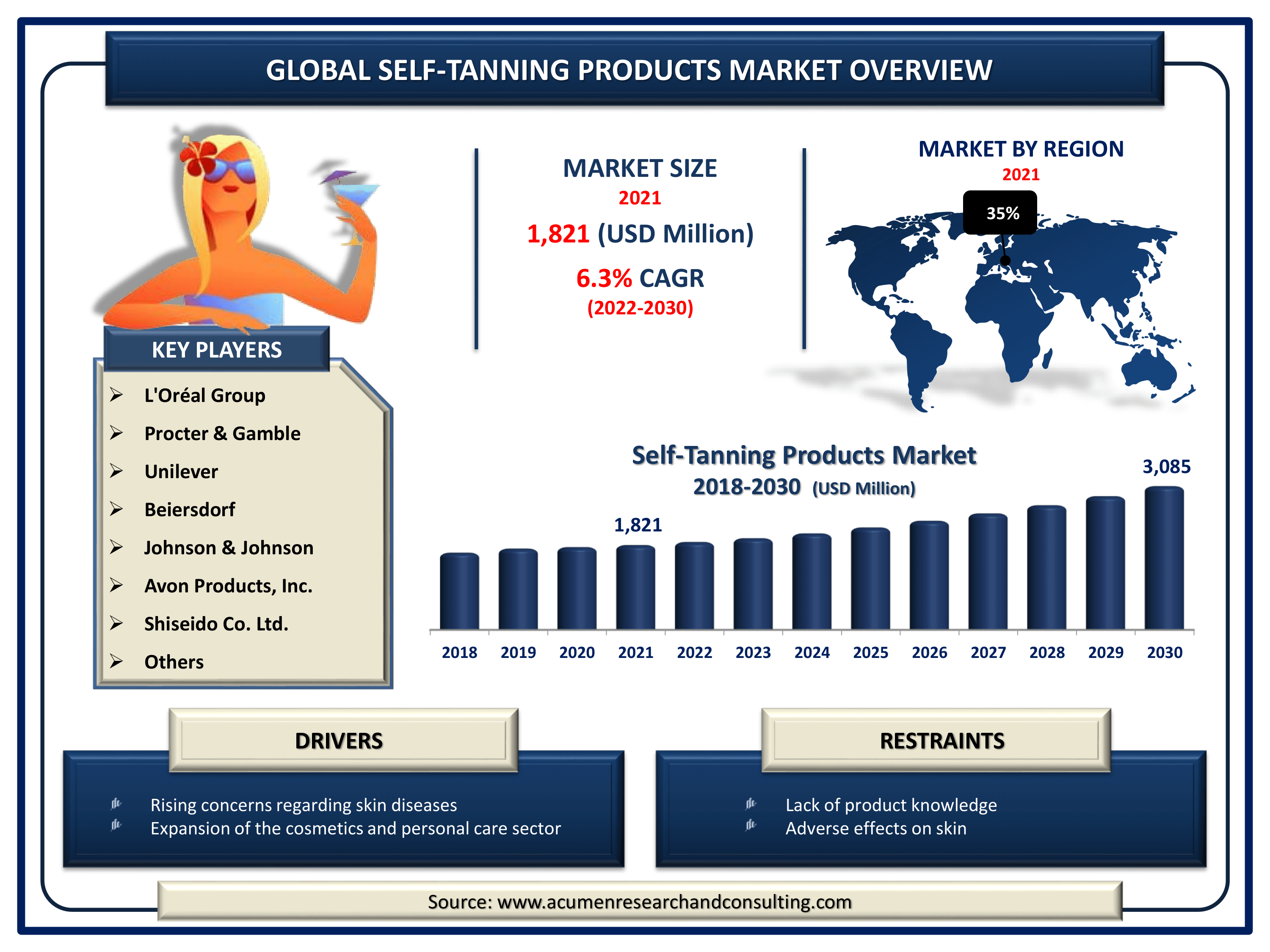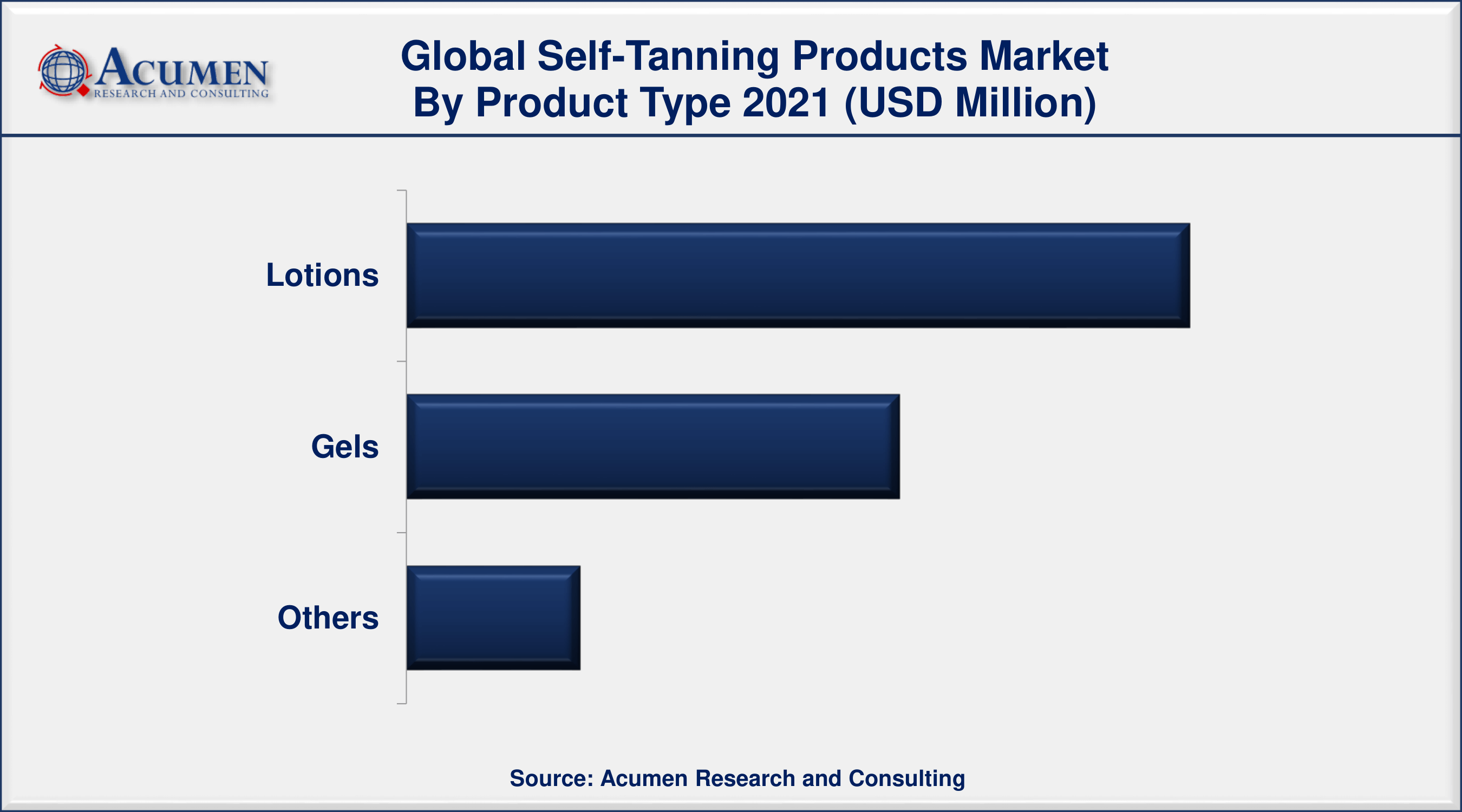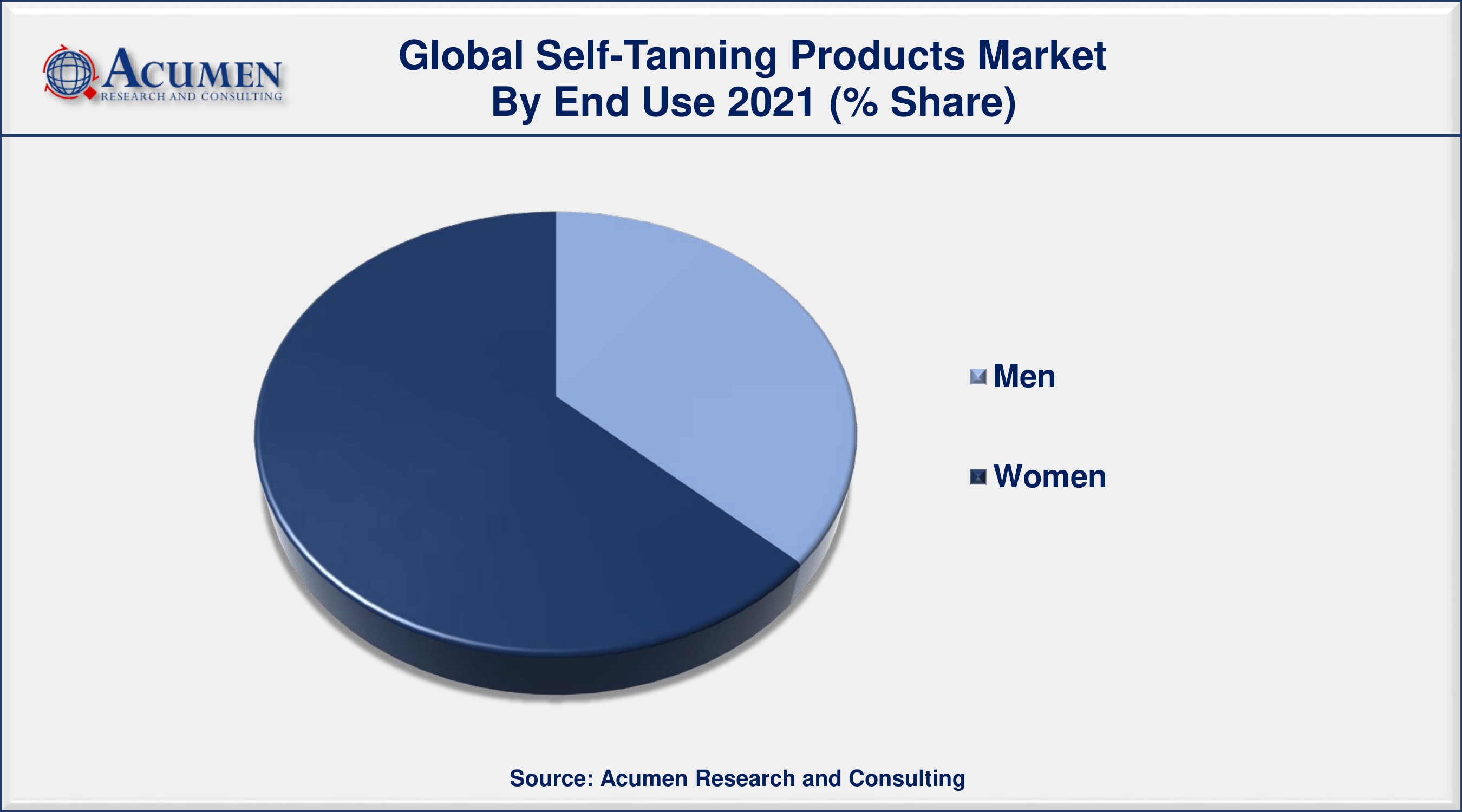Self-Tanning Products Market Size - Global Industry, Share, Analysis, Trends and Forecast 2022 - 2030
Published :
Report ID:
Pages :
Format :
Self-Tanning Products Market Size - Global Industry, Share, Analysis, Trends and Forecast 2022 - 2030
Report Coverage
- Industry Dynamics
- Market Size and Forecast Data
- Segment Analysis
- Competitive Landscape
- Regional Analysis with a Niche Focus on Country-Level Data
- High Level Analysis - Porter's, PESTEL, Value Chain, etc.
- Company Profiles of Key Players
- Option to Customize the Report As Per Your Specific Need
Request Sample Report
The Global Self-Tanning Products Market Size accounted for USD 1,821 Million in 2021 and is estimated to achieve a market size of USD 3,085 Million by 2030 growing at a CAGR of 6.3% from 2022 to 2030. Growing concerns about skin cancer and other health issues associated with sun damage will drive demand for self-tanning products. Furthermore, the expansion of the cosmetics industry and e-commerce sectors has increased the self-tanning products market value.

Self-Tanning Products Market Report Key Highlights
- Global self-tanning products market revenue is expected to increase by USD 3,085 million by 2030, with a 6.3% CAGR from 2022 to 2030.
- Europe self-tanning products market led with more than 35% market share in 2021
- Based on product, the lotion segment held around 54% market share in 2021
- Among end-use, men segment is projected to register the fastest CAGR from 2022 to 2030
- According to a recent study, approximately 90% of aging skin issues are caused by sun exposure
- According to a clinical research, having 5 or more sunburns increases your risk of developing melanoma
Self-tanners are sunless tanning products. The skin was browned without being exposed to damaging ultraviolet (UV) radiation using self-tanning products. Sunless tanning solutions are available in a variety of forms, including creams, lotions, and sprays. The color enhancer dihydroxyacetone is the primary ingredient in self-tanning products. Dihydroxyacetone combines with dead skin cells on the skin's outer surface to brown the skin and resemble a tan.
Global Self-Tanning Products Market Dynamics
Market Drivers
- Rising concerns regarding skin diseases
- The expansion of the cosmetics and personal care sector
- Rising urban population
- Emerging e-commerce and m-commerce industries
Market Restraints
- Lack of product knowledge
- Adverse effects on skin
Market Opportunities
- Increasing health-conscious individuals over the globe
- Increase in product promotion by leading companies
Self-Tanning Products Market Report Coverage
| Market | Self-Tanning Products Market |
| Self-Tanning Products Market Size 2021 | USD 1,821 Million |
| Self-Tanning Products Market Forecast 2030 | USD 3,085 Million |
| Self-Tanning Products Market CAGR During 2022 - 2030 | 6.3% |
| Self-Tanning Products Market Analysis Period |
2018 - 2030 |
| Self-Tanning Products Market Base Year | 2021 |
| Self-Tanning Products Market Forecast Data | 2022 - 2030 |
| Segments Covered | By Product Type, By Distribution Channel, By End-Use, And By Geography |
| Regional Scope | North America, Europe, Asia Pacific, Latin America, and Middle East & Africa |
| Key Companies Profiled | Estée Lauder Companies, Kao Corp., L'Oréal Group, Procter & Gamble, Unilever, Beiersdorf, Johnson & Johnson, Avon Products, Inc., Shiseido Co. Ltd., and Swallowfield. |
| Report Coverage |
Market Trends, Drivers, Restraints, Competitive Analysis, Player Profiling, Regulation Analysis |
Consumers approach towards traditional way of tanning is changing they are focused on adoption of more safe and modern ways of tanning. Gradual increase in incidence of skin cancer and side-effects of UV rays on skin is resulting in inclination towards acceptance of products such as pills and lotions. Increasing spending capacity on beauty products and rising awareness among consumers related to self tanning products are major factors expected to drive the growth of global self-tanning products market. Chancing consumer standards and high spending capacity is resulting in demand for products with better effects. Government is imposing various regulations related to use of harmful chemicals in beauty products this is resulting in manufacturers approach towards introduction of organic products. Players across the globe are focused on enhancing the business through strategic acquisition and increase the customer’s base this is expected to impact the growth of self-tanning products market. Crown Laboratories, Inc. a specialty pharmaceutical company and Hildred Capital Partners, LLC acquired Vita Liberata in 2020 the Ireland based company specializes in sunless tanning and skincare products. This acquisition is expected to help the company to enhance the business presence and increase the revenue share. In addition, St Tropez that offers self tanning products across the globe was acquired by PZ Cussons a manufacturer of Imperial Leather soaps and Carex handwashes in 2020. This acquisition is expected to help the company to enhance the business.
With the chancing competitive landscape across the globe and rising competition players are spending high in development of beauty products and introduction of modern solution such as pills and gels by major players are major factors expected to drive the growth of global self-tanning products market.
Factors such as high cost of beauty product, stringent government regulation related to product approval and side-effects of the chemical in products on skin are expected to hamper the growth of global self-tanning products market. In addition, weak distribution channel is expected to challenge the growth of self-tanning products market. However, factors such as increasing investment by major players for R&D activities and focus on introduction of organic solutions are expected to create new opportunities for players operating in the target market. In addition, major players focused on strengthening the distribution channel is expected to support the revenue transaction of target market.
Self-Tanning Products Market Segmentation
The global self-tanning products market segmentation is based on product type, distribution channel, end-use, and geography.
Self-Tanning Products Market By Product Type
- Lotions
- Gels
- Others

According to the self-tanning products industry analysis, the lotions segment held the highest market share in 2021. The rising occurrences of skin cancers and diseases caused by UV ray radiation are expected to increase lotion demand over the forecast period. Lotions contain lesser oil than creams and are occasionally fully oil-free. Lotions are also less sticky, which makes them simpler to pour and pump.
Self-Tanning Products Market By Distribution Channel
- Supermarkets & Hypermarkets
- Convenience Stores
- Online
In terms of distribution channels, supermarkets and hypermarkets are predicted to account for more than half of the market in 2021. These are commercial chain stores that offer a diverse selection of things from groceries, household stuff, and department stores to personal care items and cosmetics all under one roof. This draws customers to this mode of delivery.
Self-Tanning Products Market By End-Use
- Men
- Women

According to the self-tanning products market forecast, the men's segment is expected to grow considerably in the industry over the next few years. The significant development in the male population's consciousness of skincare has functioned as a critical driver in the past few years. Growing male awareness of personal hygiene and regular grooming, an increase in product releases and celebrity endorsements, and increased disposable money are important drivers driving the expansion of this category.
Self-Tanning Products Market Regional Outlook
North America
- U.S.
- Canada
Europe
- U.K.
- Germany
- France
- Spain
- Rest of Europe
Latin America
- Mexico
- Brazil
- Rest of Latin America
Asia-Pacific
- India
- Japan
- China
- Australia
- South Korea
- Rest of Asia-Pacific
The Middle East & Africa (MEA)
- Gulf Cooperation Council (GCC)
- South Africa
- Rest of the Middle East & Africa
North America Is Expected To Have A Significant Growth Opportunity In The Coming Years
The market in North America is expected to account for major revenue share in the global self-tanning products market due to rising awareness among consumers related to self-tanning products. Increasing consumer’s awareness related to skin diseases and adoption of beauty products as preventive measures is increasing demand for self-tanning products this is expected to boost the growth of self-tanning products market. In addition, favorable business polices by the government and introduction of innovative solutions in order to attract new customers are factors expected to boost the growth of regional market.
Self-Tanning Products Market Players
Some of the top self-tanning products market companies offered in the professional report include Estée Lauder Companies, Kao Corp., L'Oréal Group, Procter & Gamble, Unilever, Beiersdorf, Johnson & Johnson, Avon Products, Inc., Shiseido Co. Ltd., and Swallowfield.
ST TROPEZ a beauty product brand launched new Self Tan Express Bronzing Gel that uses skin caring ingredients such as Hyaluronic Acid to help skin keep moisturized and help the tan last longer. This product launch is expected to help the company to enhance the customer base and increase the revenue.
Bondi Sands an Australian self tanning brand expanded its product range with it’s first-ever line of body care products. The company offers more than 20 self-tanning products from gradual tanning milks to mists and lotions. This is expected to help the company to increase the product offering and attract new customers.
Frequently Asked Questions
What is the size of global self-tanning products market in 2021?
The estimated value of global self-tanning products market in 2021 was accounted to be USD 1,821 Million.
What is the CAGR of global self-tanning products market during forecast period of 2022 to 2030?
The projected CAGR self-tanning products market during the analysis period of 2022 to 2030 is 6.3%.
Which are the key players operating in the market?
The prominent players of the global self-tanning products market are Est�e Lauder Companies, Kao Corp., L'Or�al Group, Procter & Gamble, Unilever, Beiersdorf, Johnson & Johnson, Avon Products, Inc., Shiseido Co. Ltd., and Swallowfield.
Which region held the dominating position in the global self-tanning products market?
Europe held the dominating self-tanning products during the analysis period of 2022 to 2030.
Which region registered the fastest growing CAGR for the forecast period of 2022 to 2030?
Asia-Pacific region exhibited fastest growing CAGR for self-tanning products during the analysis period of 2022 to 2030.
What are the current trends and dynamics in the global self-tanning products market?
Rising concerns regarding skin diseases, and the expansion of the cosmetics and personal care sector, drives the growth of global self-tanning products market.
By end-use segment, which sub-segment held the maximum share?
Based on end-use, women segment is expected to hold the maximum share self-tanning products market.



